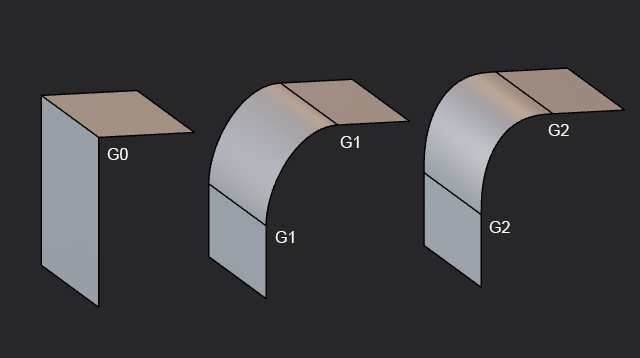Continuity of Curves and Surfaces
The continuity of a Curve or a surface refers to the smoothness and quality of the shape. The continuity is determined by the degree of matching between the position, direction, curvature, and curvature change rate of the adjacent segments.
Curve Continuity
There are four levels of curve continuity: G0, G1, G2, and G3.
- G0: Two Curves are connected, but only their positions match at the connection point.
- G1: Two Curves are connected, and their positions and directions match at the connection point.
- G2: Two Curves are connected, and their positions, directions, and curvatures match at the connection point.
- G3: Two Curves are connected, and their positions, directions, curvatures, and curvature change rates match at the connection point.
Higher continuity is required to create smoother and more natural Curves.

Surface Continuity
There are three levels of surface continuity: G0, G1, and G2.
- G0: Two surfaces are connected, but only their positions match at the connection point.
- G1: Two surfaces are connected, and their positions and tangents match at the connection point.
- G2: Two surfaces are connected, and their positions, tangents, and curvatures match at the connection point.
Higher continuity is required to create smoother and more natural surfaces.

Reference Videos
These videos utilize applications other than Plasticity for demonstration purposes, but the concepts can also be applied to operating Plasticity, so they are provided here for reference.
"Curve and Surface Continuity" - CMU PDET
Summary
The movie discusses the intricacies of curve and surface continuity, focusing on G0, G1, G2, and G3 types. It also delves into mathematical perspectives, CAD system capabilities, and practical applications in design, particularly in the automotive industry.
Types of Continuity
- G0 Continuity: Point continuity, where curves or surfaces share a point or edge but may have different slopes.
- G1 Continuity: Tangent continuity, where there is G0 continuity and the slopes of the curves are the same.
- G2 Continuity: Curvature continuity, which includes G0 and G1, plus the curves have the same rate of curvature.
- G3 Continuity: Adds an acceleration component to G2 continuity.
Mathematical Perspective
- G0: The functions representing the curves are not equal at any particular point.
- G1: The first derivatives of the functions are equal, meaning they have the same slope.
- G2: The second derivatives are equal, indicating the same rate of curvature.
Visual Analysis Methods
- Zebra Stripe Analysis: Used to evaluate how well curves or surfaces blend and reflect light.
- Porcupine Analysis: Another method to visually assess the quality of curves and surfaces.
Automotive Design Standards
- Class A Surfaces: Visible to the user and typically require G2 or better continuity.
- Class B Surfaces: Visible when the product is not in use and have lower continuity requirements.
- Body and White Surfaces: Not visible to the user and can have G0 or better continuity.
Final Remarks
The quality of your design can be significantly impacted by the type of continuity you choose. This is especially true in industries like automotive design, where the aesthetic and functional aspects are critical.